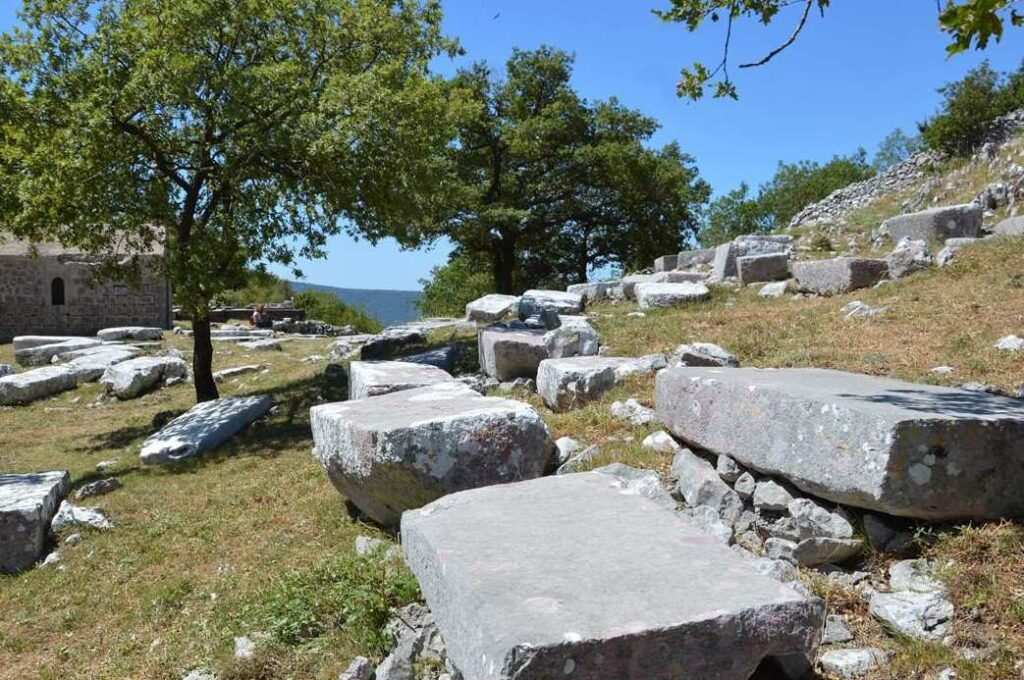The site of St. Barbara is located in the village of Dubravka, in the northeast part of the Konavle region, where Croatia shares borders with Montenegro and Bosnia and Herzegovina. The site is situated at the very beginning of a pass that forms a gap between the mountain of Sokoline on the west and Kočine, or rather, Greda, on the east. This pass is the only natural link between the eastern part of Konavle and the hilly interior. The natural position of the settlement is very favorable for agriculture, rich in fresh running water and sunshine. Fertile land cascades down the mountains towards the Konavle valley. Thanks to these favorable conditions, the St. Barbara site and the surrounding area have enjoyed the ideal prerequisites for continuity of human settlement since prehistoric times.
Evidence of early human activity includes the remains of fortified settlements known as Castellari and stone grave mounds in the immediate vicinity of the site, as well as remnants of antique and medieval activities. Southeast of the church and graveyard lies the mountain of Straža (559 m), and a Bronze Age settlement that controlled the pass and roads towards the interior. In the late Middle Ages, there was probably a Dubrovnik Guard Station at this site. Later, the site was used by Austrian authorities, and still later by the Italian military during World War II. In more recent times, the guard station was also used by Croatian soldiers during the War for Independence. A dozen meters southwest of the site of St. Barbara there is a preserved prehistoric stone mound over which drywall was built to mark ownership of the pastures.
Among the most prominent remains of the late Middle Ages in Konavle are the monumental, tombstones known as stećci (plural, pronounced stech-tsee). Stećci are widespread throughout the Western Balkans. The oldest examples date from the second half of the 12th century, while the most richly decorated examples are from the 14th and 15th centuries. In the 16th century the production of stećci gradually disappeared, and in Konavle production already ceased in the 15th century when Konavle became part of the Dubrovnik Republic.
However, there remains the eternally intriguing question of who was buried underneath the stećci? In the past, it was considered that these were Bogumili burials, but recent studies suggest that burial under the stećci was not related to ethnic or religious affiliation, but rather to wealth. Only those who could afford it were buried there.
In the area of Dubrovnik-Neretva County, there are 115 sites with stećci, out of which 24 are found in Konavle. The most famous among them is the site of St. Barbara in Dubravka. In 2016, together with 27 other sites in Croatia, Bosnia, and Herzegovina, Serbia, and Montenegro, the site of St. Barbara was added to the UNESCO World Heritage List.
There are 104 stećci (slabs and chests) dating from the 14th and 15th centuries, of which 94 are whole and 10 are fragments. They are enclosed by drywall with two entrances made from repurposed stećci. 31 of them are decorated, with motifs of stylized vines, shields, rosettes with crosses, bow and arrows, arms and fists.
The existing single-nave church with a simple rectangular floor plan and a barrel-shaped vault was built on the site of an older church in 1889. Archaeological and conservation works established the existence of the flooring of an earlier, probably late-medieval church. The church was recently restored with support from the Society of Friends of Dubrovnik Antiquities.
Although there are more richly decorated examples of stećci in Konavle, the site of St. Barbara was listed on UNESCO’s list due to its integrity and preservation. The medieval necropolis, which was not disturbed by the consequent burial activities, nor by the need for expansion and change in active cemeteries, remained as a testament to a far-off time as a passing station in the main communication path between different worlds. The stećci have thus become the cornerstone of planning for cultural historical routes and tourist activities in Konavle.
Published in the first issue of the magazine In love with Konavle.




